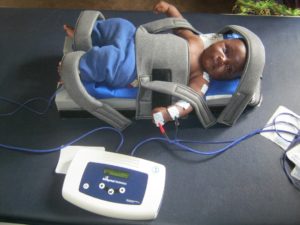Background.
Pneumonia remains the leading cause of infectious deaths amongst children under-five worldwide, with the highest burden seen in sub-Saharan Africa. Despite considerable progress in reducing pneumonia related morbidity and mortality there is still a considerable burden and therefore, new approaches to pneumonia diagnosis, treatment and prevention are needed. In Malawi we have found that acute malnutrition (measured with MUAC in the community and weight-for-age at the hospital level) is a key predictor of treatment failure and mortality in children diagnosed with pneumonia. An early accurate identification of children who are acutely malnourished could be a strategy to reduce mortality, as these children could then be referred into more intensive care.
Measures such as weight, length and MUAC are non-specific regarding tissue masses and properties. When children are of low weight or thin, it is not clear whether the key deficit derives from components of lean mass, or from adiposity. Further, physiological states such as oedema confound the interpretation of data on weight, and potentially MUAC. There is therefore a need for more detailed information on body composition and physiological condition. Bio-electrical impedance analysis is a potential method of improved measurement as it can differentiate tissue quantities and properties, and be applied to different body segments. This technology may therefore improve the ability to predict deteriorating health or mortality arising from diseases such as pneumonia. Specifically, Bioelectrical impedance vector analysis ( BIVA) produces several outputs that collectively index the quantity of cells, cell membrane integrity and permeability, and the distribution of extracellular and intracellular fluids by applying an electrical current.
Biva is measure using a small portable, non-invasive machine. Source and sensing electrodes are placed on the hand and foot for whole-body measures, moving the sensing electrodes to the shoulder and lower trunk for segmental measures of the limbs and trunk. Each measure takes just a few seconds. BIVA has previously been used in studies of severe-acute malnutrition in sub-Saharan African populations; however, it hasn’t been evaluated in children who present with pneumonia but don’t meet the WHO definitions of malnutrition, as an alternative measure to weight for age/height or MUAC
Aim
This is a feasibility study investigating whether BIVA can effectively be used in children diagnosed with pneumonia in Mchinji District, Malawi.

